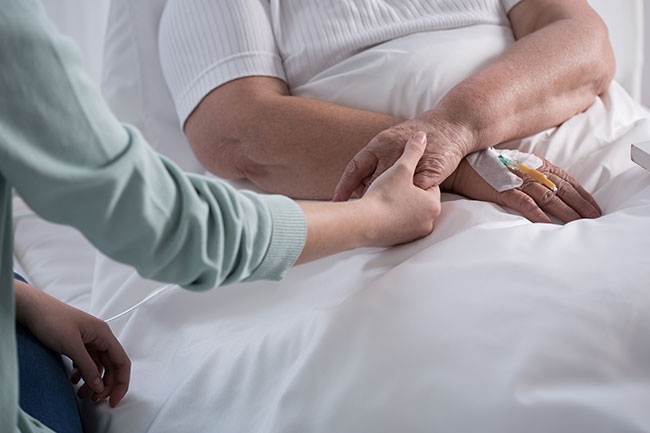
Features
Practice
Market outlook
Legalized marijuana, the growing opioid crisis, technology innovation, research and education – these are some of the hottest issues in health and health care management to watch for in 2018.
December 22, 2017 By Mari-Len De
 Clinicians are increasingly looking at massage therapy as part of cancer care. Legalized marijuana
Clinicians are increasingly looking at massage therapy as part of cancer care. Legalized marijuanaMassage Therapy Canada’s editorial advisory board members offer their take on these trends and their impact on the massage therapy profession at a recent conference call.
Following are the highlights of the discussion.
Opioid crisis
One of the biggest public health issues of 2017 is the opioid crisis, which claims 8.8 lives per 100,000 population, according to data from the federal government. The epidemic is expected to continue into 2018 even as public health organizations, various health-care associations and other stakeholder groups look for meaningful ways to help alleviate this national crisis.
There is opportunity for the massage therapy profession to engage in finding solutions to the crisis, particularly as it relates to chronic pain, says Donelda Gowan-Moody, a registered massage therapist from Saskatchewan and research chair at the Massage Therapist Association of Saskatchewan.
“I had a lot of opportunities to engage with pain science researchers and there’s a tremendous amount of interest in massage therapy as a non-pharmacological intervention for chronic pain,” Gowan-Moody says.
The trend toward non-pharmacological interventions for managing pain provides an opportunity for manual therapists, including massage therapists, to have a seat at the table in developing policies aimed at reducing people’s dependence on powerful opioids to manage their pain.
Toronto-based RMT Jason White agrees practitioners need to have a better understanding when it comes to patients suffering from chronic pain.
“I think (chronic pain) will be an emerging topic for RMTs,” White says.
For starters, Gowan-Moody explains, there needs to be a general understanding that chronic pain is “considered to be a condition in and of itself.”
Unlike other health care professions, the role of massage therapy in pain management has yet to receive mainstream recognition. However, as the opioid crisis continues to highlight the need to address people’s pain problems, the window of opportunity for massage therapy gets wider, and education will play a critical role – both on the side of the public and the RMTs.
“There’s the communication aspect – how do we tell our patients and the public at large that we can be helpful,” says Paul Kohlmeier, president of the Massage Therapy Association of Manitoba. “Give (RMTs) the tools they need to communicate this to patients or through their own marketing and advertising for their clinic so that there’s a more unified message coming from the profession as a whole.”
Professional education is also key and the fact that not all massage therapists in Canada are regulated. This means training and education vary from province to province, and can be as short as 250 hours in unregulated provinces.
Advocating for the profession as an effective non-pharmacological alternative to opioids will be a challenge, given the jurisdictional differences.
“How can we advocate for massage therapy being an option if we can’t actually, with good confidence, state that massage therapists would consistently provide quality care to address those issues,” says Beth Barberree, RMT and clinic director for Massage at the Club in Calgary. Alberta’s massage therapy profession is yet to achieve professional regulation. Barberree is the co-founder and president of the Alberta Support Council for Massage Therapy, an advocacy group established in 2016 with the sole purpose of supporting processes and activities toward massage therapy regulation in the province.
“As a therapist in Alberta, I would like to see more information about chronic pain, the management of chronic pain and current research in chronic pain coming out to the practitioners,” Barberree says.
Availability of more chronic pain management education for massage therapists would help increase practitioners’ competencies in pain management, says Mike Dixon, RMT at Electra Health Floor in Vancouver.
Marijuana
One of the hottest issues anticipated to dominate 2018 is the impending legalization of recreational marijuana. While much of the discussions focus around access and dispensing policies, health-care practitioners are looking at the issue from a different angle.
Much of the concerns surrounding the legalization is the lack of information coming from the government and regulatory bodies around the health implications of recreational marijuana.
Some RMTs are already seeing patients who use marijuana for medicinal purposes, such as for chronic pain or post-traumatic stress disorders, says Scott Andrew, instructor and clinical supervisor at the Atlantic College of Therapeutic Massage in Fredericton, N.B. However, when recreational marijuana use becomes legal, practitioners may see more clients coming in for treatment under the influence – whether for medicinal or recreational purposes.
“There are concerns, as a practitioner, over trying to find more information on perceived pain levels for the application of techniques. How well can that individual, who has taken marijuana… perceive treatment that we’re applying to them?” Andrew notes.
Some of the questions that need to be answered for practitioners around marijuana include: When is it safe for a RMT to provide treatment to someone who has consumed marijuana? How long does the effects of the substance remain in a person’s system?
“In my own practice, I’ve seen it as well, too, and I’ve had to contact my mentors to get information on how it affects things like craniosacral technique. What I get is a totally different feel from an individual who’s using medicinal marijuana and I’ve heard that from others,” Andrew says.
It is prudent for RMTs and other health practitioners to brush up on available knowledge about marijuana and its effects on the user population. Having sufficient knowledge on how to handle and communicate with patients who use marijuana will go a long way in establishing boundaries between patients and practitioners.
“There are different levels of ‘under the influence’,” says Jason White. “Patients don’t do it just to get that high, they do it to eliminate their pain. Some patients come in and they want to share their knowledge, they want to show the benefits they are getting from it.”
It’s also important for RMTs to understand the distinction between recreational use and medicinal use, Kohlmeier says. People take medicinal marijuana to help alleviate certain medical conditions, and most of the time it’s to help with the pain – the same way people take opioids or NSAID for pain relief.
The challenge, however, is that there is no sufficient literature that currently exists that can inform a health practitioner on dosage information when it comes to medical marijuana use, which makes it difficult to determine whether they are able to give consent to treat or whether there’s impairment.
“With most medical marijuana there’s no dosage attached to it,” says Kohlmeier. “So where is the line between getting the pain gone and getting the high or recreational effects? That’s an inherent problem with this and from that we are going to have to see some guidelines around it.”
While it is important for practitioners to be aware of the potential issues and questions that may come up with marijuana legalization, Dixon from Vancouver cautions that RMTs, being a drugless practitioner, need to refrain from making recommendations about marijuana to their patients, and to refer patients to the appropriate professional.
Research
Building research capacity for the massage therapy profession continues to be on the agenda of those pushing for inclusion of massage therapy in mainstream health care discussions. Although considered to be in its infancy, Gowan-Moody maintains massage therapy research is slowly building and opportunities to collaborate with other disciplines on research and other scholarly work are increasing as well.
“I would encourage the profession to be thinking about what are some of the problems that we are facing, and formulate some research questions in order to create knowledge, in order to have an impact on solving problems,” Gowan-Moody says.
One emerging topic of research in massage therapy is its role in oncology and integrated care for cancer patients. The massage therapy profession in Saskatchewan has been invited to participate in an integrative oncology project with the University of Saskatchewan, according to Gowan-Moody.
“Researchers are looking at massage therapy as part of survivorship care for post-radiation, post-chemotherapy. Massage therapy and cancer care seems to be quite intriguing and it’s risen in both research and clinical practice interest,” she says.
Members of the editorial advisory board believe the profession can do a lot more in building research capacity, and it starts at the education level. However, regulation and standardized education across Canada may be necessary ingredients to achieve this goal.
“Education across the country being standardized would be a good starting point,” Barberree says, noting that standardized education will be a consequence of professional regulation. “Also it ties to the degree program and how we can build research awareness, at the very least, into more advanced training program.”
Another area of potential research opportunity is in working with health advocacy groups and developing research studies on the effects of massage therapy on specific medical conditions, suggests Dixon.
“What I did back in 2004, when I worked at West Coast College of Massage Therapy, was that we (reached out to) people with multiple sclerosis and we had an opportunity to do research on 67 or 68 clients,” Dixon recalls. His group studied the effects of massage therapy on MS patients. The results of that study was developed into a poster presentation, Dixon says.
2018 digital marketing trends for health professionals
Influence marketing
It might be time to work on your social media skills, as this may be the new window to acquiring new clients. According to statistics from Ogilvy Cannes, 74 per cent of the population turn to social networks for guidance on purchasing decisions. Another statistic indicates 71 per cent of patients are more likely to choose a health care provider based on a reference on social network. Consider it your new “word-of-mouth” marketing.
Website
A health provider’s website is often the first place a potential client will visit before booking an appointment. Make sure yours or your clinic’s website is responsive and built for compatibility – whether a client is viewing it on a desktop, a tablet or a smart phone.
Content is king
Competing for attention in the ever-widening world of digital marketing will require more than simply having a website and a few social media accounts. According to a report from Demand Gen, 47 per cent of buyers viewed three to five pieces of content before engaging with a product or service provider. Consider providing visual content (images, infographics, videos), as it is 40 times more likely to get shared on social media than other types of content.
Social media
Considering that nearly a third of the world’s population are engaged in social networks, it might be time to think about focusing some of your marketing efforts on your social media presence. Use social media to draw people to excellent content residing on your responsive website, and to connect with top influencers in health care and effectively build up your digital profile.
Say, ‘Hey Siri!’ According to Google, 20 per cent of search queries on its mobile app and on Android devices are voice searches. Voice search is the new frontier for online search engine optimization. Make sure you optimize content on your web pages for keywords people will use in their voice searches to find a local RMT, for instance.
———
Mari-Len De Guzman is the editor of Massage Therapy Canada magazine. You can contact her at mdeguzman@annexweb.com.
Print this page


